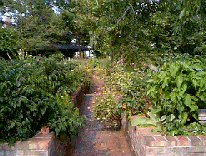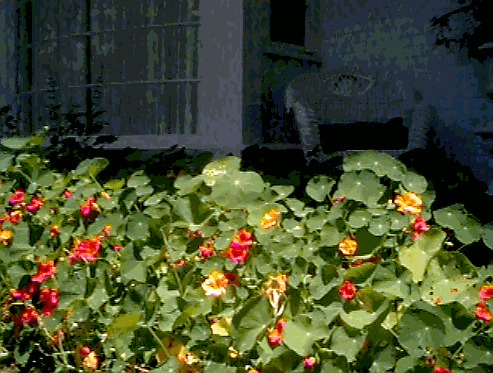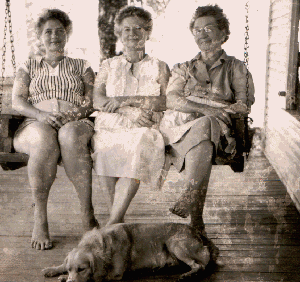Herb Gardening
I am blessed in knowing the skilled gardeners in my area. Luke Cooley is not
only the expert on herbs in our area (she designed the herb garden at our
Botanical Gardens); she is also the probate judge. Her garden club challenged
the members to actually plant a garden. Knowing her busy schedule would dictate
the time she would have for tending a garden, Luke studied up a bit and
discovered that herbs are hardy and drought resistant, requirements for someone
who wants to reap the benefits of blooms, aroma, and bounty for the kitchen with
minimal effort.
She has become such an admirer of herbs that she waxes poetic on the subject.

"Herbs seem to weave a spell over those who know them. Diet and health
have caused a rejuvenation of these wonderful, fascinating weeds. Even the
smallest herb garden can be a place of enchantment on a warm summer day.
You can watch bees sip nectar from tiny thyme or rosemary blossoms; inhale
fragrance from scented begonias, be enchanted with hummingbirds in your Mexican
sage or watch dewdrops glisten and sun warm your coral bells.

If you don't have a garden, then herb wreaths and potpourris might warm your
senses; tussey mussies sent to convey your thoughts; or center pieces and
decorations enhance your home. Your taste buds will be delighted at the
subtleness of their flavors. Beware! Once enchanted, they will enhance
your life and touch those you love."
Luke's Herb Garden
"Herbs are foremost cultivated weeds and thrive on benign neglect. They
like to be fed and watered but do not like heavy fertilization and they like
their feet dry. If you grow in pots, be sure and leave space between
cement and pot or put rocks in the bottom. If you're growing in beds,
raise them at least one landscape timber."
"In winter cover herbs with pine straw or wood chips to keep weeds down.
Pull the covering in the spring so volunteers can come through. Dawn
dishwashing liquid and water is the best insecticide."
Note: Fall is the perfect time to grow those herbs that seem to
melt in our summer heat: such as, lavender and santolina.
Soil preparation is important. Luke recommends that soil be
at least one part compost, one part sand, one part manure (or mushroom) and
one part topsoil. "Sprinkle with lime. If you're growing in the
house, fertilize with Pro Sol. In the South, one-half day of sunlight
will suffice but most will take a full day if you wish."
Tips from Luke on Cooking with Herbs
Some husbands do not appreciate little bits of things floating about in
their food. You can get the flavor and remove the evidence with a
ceramic tea caddie.
When experimenting with herbs, remember it is easier to add than take
out.
Herb blends should be subtle. Use one basic herb and blend from it.
Basil, rosemary, oregano, thyme, sage, and tarragon are dominant herbs.
As a rule, they do not mix well with each other.
Use twice as much fresh herbs as dried.
Drying Herbs
"Properly dried herbs can be as pretty, fragrant and flavorful as those fresh
from the garden. For best results, pick herbs on a clear day after the dew
dries but before the sun has time to dissipate their essential oils.
Many herbs can be dried by tying them in small bunches (6-12 stems) at stem
ends, then hanging them upside down for a few days in a warm well-ventilated
room. Keep them away from sunlight and away from the stove."
Tussie Mussie: A tussie mussie is a nosegay which dates back to the
seventeenth century when a bouquet of flowers was used to deliver a message.
Basil meant good wishes; borage, courage; burnet, merriment; rose geranium,
preference; marjoram, joy; rosemary, remembrance; sage, good health; thyme,
happiness; valerian, pleasure. Arrange herbs and flowers in a small bouquet and
tie the stems together. Place a paper doily under the flowers and add colored
ribbons.
Microwave Shortcut Put herbs in microwave on paper towels.
Microwave for 30 sec. Then do more if necessary. Oils may pop and burn.
Nasturtium Sauce: This is made by stirring into one teacup drawn butter,
three tablespoonfuls pickled nasturtiums, adding a little salt and pepper.
Simmer gently and serve.
Mint Sauce: 3 tablespoonfuls vinegar, 2 tablespoonfuls mint. 1
tablespoonful powdered sugar, 1 saltspoonful salt
Lemon Verbena Tea
Recipe By :Doris Johnston
Water
Tea
Recipe for lemon verbena tea
Doris got instructions on perfect brewing from an English lady who knows the
art of brewing tea. The tea kettle must be warmed with hot water poured off
before it is filled with the water to be used with the tea. As the tea comes to
the point of boiling it should be poured over one teaspoon of dried verbena or
two teaspoons of fresh verbena. Steep. Strain and serve. Doris uses one of those
elegant English tea strainers, making a ceremony out of drinking tea.
Metal pots will make tea bitter. Always use china or glass pots for tea
making.
Bee balm, calendula, chamomile, hyssop, lemon balm and sage make good teas.
To flavor cold teas, use the same herbs in the same proportion as for hot
teas. Prepare the cold drink twelve to twenty-four hours in advance if you plan
to steep it in cold water. Or steep the tea in boiling water and then chill in
the refrigerator or freezer.
Herbal vinegar: Herbal vinegar can be made with white, cider, or wine
vinegar. Use white vinegar if you want to show off the color or herbs, such as
chive blossoms or purple basil. Mix 1 tablespoon of dried herbs of ½ cup of
fresh herbs with 2 cups of vinegar. Allow this mixture to stand in a covered
glass in a warm, dimly lit place for four to six weeks. Strain out the herbs,
and store the vinegar in a labeled glass jar or bottle. (Basil, burnet, caraway,
chive flowers, dill, fennel, garlic, lavender, lovage, marjoram, mint, oregano,
parsley, rosemary, sage, savory, scented geraniums, tarragon and thyme make good
vinegar.)
Luke Cooley has inspired me with her herb gardening. I have begun planting
more herbs. My favorites are guarantica salvia with its sapphire blooming spires
(indeed, sage of all kinds) and artemesia (because it roots and divides so well
and smells wonderful!). Gardening has inspired me to become a better cook and so
I have begun studying cooking as an art rather than as a necessity, which makes
cooking more of a pleasure than a chore. As usual, when I decide to do something
I get inspired by the research I do on it. As a result I have developed a
sincere appreciation for those homemakers in my ancestry who made a "home" for
their families with the foods they created using the information they had
acquired from their mothers on taste, nutrition, and presentation. They had to
grow what they served their families and they did it with love and creativity.
This book
is in part a desire to
organize what I have learned and share it with those who might also be
interested.
Wine
Marion Cabell Taylor gave clear instructions on winemaking in her book
Housekeeping in Virginia.
"Be sure to get perfectly ripe fruit for making wine, but do not gather it
immediately after rain, as it is watery then and less sweet than usual.
Be very careful to stop the wine securely as soon as fermentation ceases, as
otherwise it will lose
its strength and flavor. Watch carefully to see when fermentation ceases.
Strawberry wine makes a delicious flavoring for syllabub, cake, jelly, etc.,
and so does gooseberry wine. Dewberries make prettier and better wine than
blackberries, and have all the medicinal virtues of the latter.
The clearest wine is made without straining, by the following process: Take a
tub or barrel (a flour-barrel for instance), and make a little pen of sticks of
wood at the bottom. On top of this pen lay an armful of clean straw. Bore a hole
in the side of the tub or barrel as near the bottom as possible, and set it on a
stool or box so as to admit of setting a vessel underneath it. After mashing the
berries intended for wine, put them on top of the straw, and let the juice drain
through it and run through the hole at the side of the tub or barrel into the
vessel set beneath to catch it. Be careful to have this vessel large enough to
avoid its being overrun. Any open stone vessel not used before for pickle will
answer, or a bucket or other wooden vessel may be used. Let the berries remain
on the straw and drain from evening till the next morning. Some persons make a
slight variation on the process above described by pouring hot water over the
berries after putting them on the straw. After the draining is over, an inferior
sort of wine may be made by squeezing the berries.
The following process will make wine perfectly clear: To a half-gallon of
wine put two wine-glasses of sweet milk. Stir it into the wine and pour it all
in a transparent half-gallon bottle. Stop it and set it by for twenty-four
hours, at the end of which time the wine will be beautifully clear, the sediment
settling with the milk at the bottom. Pour off the wine carefully into another
bottle, not allowing any of the sediment or milk to get into the fresh bottle.
The same directions apply to vinegar.

Naomi Kennedy, Joe Jernigan, and Jean Gillis
My mother, Jean Gillis Burson, remembered getting tipsy on Aunt Rosa’s
Scuppernong wine with her cousins Naomi and Joe. It was a cloudy day and they
were sitting on the porch between the kitchen and the house at Aunt Rosa’s. They
were getting a bit snockered sneaking swigs of the forbidden wine when the rain
started. Joe put on a straw hat. Mother remembers Naomi getting so tickled at
the sight of Joe in a straw hat in the middle of a rainstorm. At 79 mother would
still laugh remembering Naomi’s unrestrained and very infectious giggles.
Daddy, Dr. E. G. Burson, remembered his mother giving him a small glass of
wine for stomachaches. He remembered having a lot of stomachaches.
Scuppernong Wine
(A scuppernong is a native grape that grows in the Deep South. It is
considered a bronze Muscadine that is only female and needs a pollinator.
Scuppernong arbors are a common sight in the South.)
Take any convenient quantity of perfectly ripe grapes. Mash them so as to
break all the skins, and put them in a tub or other clean vessel, and let them
remain for twenty-four hours; with a cider press or other convenient apparatus,
express all the juice, and to each gallon of juice thus obtained add from two to
two and a half pounds of white sugar (if the grapes are sweet, two pounds will
be enough, put the juice and sugar in a keg or barrel, and cover the bung hole
(def. "a hole in a barrel or keg for pouring or drawing out liquid") with a
piece of muslin, so the gas can escape and dust and insects cannot get in; let
it remain perfectly quiet until cold weather, then bung it up tightly. This wine
will need no clarifying; if allowed to rest perfectly still it can be drawn off
perfectly clear.
Grape Wine
Pick the grapes from the bunch, mash thoroughly, and let them stand
twenty=four hours. Then strain and add three pounds of sugar to every gallon of
juice. Leave in a cask six months, and then bottle, putting three raisins in
each bottle.
Wild Black Grape Wine
Pick the grapes from the stem and cover with water. Mash and strain
immediately. Add three pounds white sugar to one gallon juice. Garden grape wine
is made in the same way. If you prefer a red wine, let the water stand on the
grapes all night. The light wine is the best, however. This wine has to be kept
much longer than blackberry wine before it is fit for use.
Blackberry Wine
Fill large stone jars with ripe black or dewberries. Cover them with water,
mash them, and let them stand several hours, or, if freshly gathered, let them
stand all night. Then strain through a thick cloth and add three pounds white
sugar to each gallon of juice. Let the wine stand a few days in the jars,
stirring and skimming each day. Put it in a demijohn (def. "a large bottle of
glass or earthenware in a wicker casing"), but do not cork it up for some time.
Blackberry Wine
Measure the berries and bruise them; to every gallon adding one quart of
boiling water. Let it stand twenty-four hours, stirring occasionally; then
strain off the liquor into a cask, adding two pounds sugar to every gallon. Cork
tight and let it stand till the following October, when it will be ready to use
without further boiling or straining.
Blackberry Wine
One bushel very ripe berries makes ten gallons wine. Mash the berries as fine
as possible and pour over them a water-bucket of clear spring water. Cover it
and let it stand twenty=four hours to ferment. Next day strain through a cloth,
and to every three quarts juice add two quarts clear cold water and five pounds
common brown sugar. Pour in a demijohn or runlet, reserving some to fill the
vessel as fermentation goes on. After six or eight days, put to every ten
gallons one half box gelatine. After two weeks, cover the bung-hole with a piece
of muslin. Two or three weeks later, cork tightly and then leave undisturbed for
six months. After that time, bottle and seal. Superior currant wine may be made
by this recipe.
Blackberry Wine
Fill a large stone jar with the ripe fruit and cover it with water. Tie a
cloth over the jar and let them stand three or four days to ferment; then mash
and press them through a cloth. To every gallon of juice add three pounds of
brown sugar. Return the mixture to the jar and cover closely. Skim it every
morning for more than a week, until it clears from the second fermentation. When
clear, pour it carefully from the sediment into a demijohn. Cork tightly, set in
a cool place. When two months old it will be fit for use.—Mrs. R.E. Lee (Copied
from a recipe in Mrs. Lee’s own handwriting by Marion Cabell Tyree)

Elkanah Burson served proudly for 3 years under General Lee’s command and
surrendered with him at Appomattox
Sweet Watermelon Pickle
Trim the rinds nicely, being careful to cut off the hard coating with the
outer green. Weigh ten pounds rind and throw it in a kettle, and cover with soft
water; let this boil gently for half an hour, take it off and lay it on dishes
to drain. Next morning put one quart vinegar, three pounds brown sugar, one
ounce cinnamon, one ounce mace, the white of one egg well beaten and thrown on
top of the liquid (to clear it as you would jelly), three teaspoonfuls tumeric,
all together in a kettle, and boil for a few minutes. Skim off what rises as
scum with the egg. Throw in the rind, and boil for twenty minutes. The peel of
two fresh lemons will give a nice flavor, though not at all necessary.
(These delicious sweet pickles were served at The Cotton Patch, a restaurant
famous for its delicious food in Eutaw, Alabama and a favorite for generations
of University of Alabama students to go and eat.)
Watermelon Pickle
2 pounds watermelon rind.
2 pounds sugar.
1 pint vinegar.
Mace, cloves, cinnamon, and ginger to the taste. Peel the rind and cut in
pieces; boil in ginger tea till clear, then throw in cold water overnight. Next
morning make a syrup and preserve the rind; just before taking off the fire,
pour in the vinegar.
Candied Flowers from herbs
Brush beaten egg white on the flower, then lay them on wax paper and sprinkle
them with powdered sugar. Dry in a sunny window (it will take two or three
days), or in a 200 degree oven for half an hour. Flowers can also be candied by
dipping them in a sugar solution, and then sprinkling them with granulated
sugar. (Borage can be candied and used as a decoration on cakes.)

Jean Gillis Burson, Eunice Jernigan Gillis, Rosa Jernigan Kennedy
Nasturtium Vinegar
1 cup rinsed nasturtium flowers and leaves
1 tablespoon chopped green onion
1 clove garlic, halved
¼ teaspoon peppercorns
2 pints red wine vinegar
Put flowers and leaves in 1 quart jar. Add onions, garlic, peppercorns, and
vinegar. Cover; store 2 weeks. Add 1/r teaspoon salt. Strain. Bring to boiling.
Pour into hot, clean bottle. Seal.
Pear Preserves
4½ pounds pears
6 cups of sugar
2 tablespoons of whole cloves.
Pears should be picked a week or two before using. Peel the pears and cut
them into uniform sized pieces. In a deep, heavy pot, add the sugar and pears
alternately. Start to cook the pears on low heat until a syrup has formed in the
bottom of the pot. Then turn the heat to high and cook the mixture rapidly until
the syrup will flake from a spoon. Approximately 10 minutes before removing the
pears from the heat, add the whole cloves. When cooked , place in hot sterilized
jars and seal. Makes 6 to 8 pints.
Fig Preserves
1 cup sugar for each rounded cup of figs
1 lemon, sliced thin
Pinch of soda
Wash and pick over the figs. In a container large enough to cook in, cover
the figs with sugar. Let the figs sit over night in the refrigerator. The next
day, remove the figs from the refrigerator and add the thinly sliced lemon,
mixing down into the fruit. (1 lemon for every 5 or 6 pounds of fruit. Be sure
to remove yellow, but not the white inner rind.) Do not make more than 8 to 12
pounds at one time, that it may cook rapidly and be a beautiful pink color when
done. If cooked in larger quantities, preserves will be dark. Cook the figs in
the same pan used to sugar down in for 3 hours over low heat until the syrup
becomes thick. Test the syrup by spooning it into a saucer periodically. When
the syrup reaches the right consistency, add a pinch of soda and put the mixture
into sterilized jars. Cool slightly before sealing. At the end of 30 minutes,
tighten the jars and cool completely before storing. (one basket of figs makes
at least 10 pints of preserves.
Pear Honey
Peel and core fruit and run through meat grinder using muslin disc. For each
pound of fruit, allow ¾ pound sugar. Cook until done, stirring constantly. When
ready to remove from fire, add 1 can grated pineapple.
Pear Preserves
5 pounds pears, run through food chopper, 5 pounds sugar, 2 small cans grated
pineapple. Mix and boil until it jellies.
Apple/Geranium Jelly
6 cups of apple juice (about 5 pounds of apple)
4 cups of sugar
12 rose geranium leaves
Prepare juice by removing stem and blossom ends of tart, red apples. Slice
and put in kettle with water, barely to cover. Cook until very tender. Burn into
jelly bag, let juice drip into bowl.
Measure 6 cups of juice into a large kettle; bring quickly to a boil. Add
sugar, stirring until dissolved. Boil rapidly until jellying point is reached.
Quickly place 2 small (or 1 larte0 rose geranium leaves in each hot jar. Skim
jelly and pour into hot glasses or jars. Cover with paraffin at once. Or adjust
lids on jars and process in boiling water bath (212 degrees Farenheit). 5
minutes. Remove from canner and complete seals unless closures are self-sealing.
Makes 6 half pints.
Mint Jelly: Omit geranium leaves. Tint jelly just before pouring into jars
with green food color; add ½ teaspoon of peppermint extract.
Crab Apple Jelly
5 pounds crab apples
8 cups water
Sugar
1 teaspoon vanilla
Remove stem and blossom ends from washed crab apples, cut in halves and put
in large kettle. (Red fruit makes the most colorful jelly.) Add water and cook
until fruit is very soft, about 10 minutes.
Strain mixture through jelly bag but do not squeeze or force juice through
bag.
Measure juice. You should have about 7 cups. Stir in ¾ cup sugar for every
cup of juice. Bring to a boil quickly and cook rapidly until jellying pint is
reached.
Skim off foam, stir in vanilla and pour into hot glasses or jars. Cover with
paraffin at once. Or adjust lids on jars and process in boiling water bath (212
degrees Farenheit.) 5 minutes. Remove from canner and complete seals unless
closures are self-sealing type. Makes about 4 half pints.


